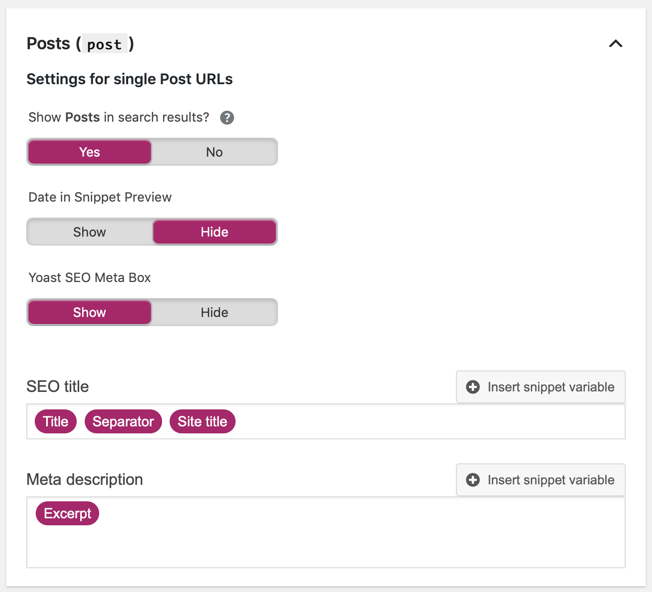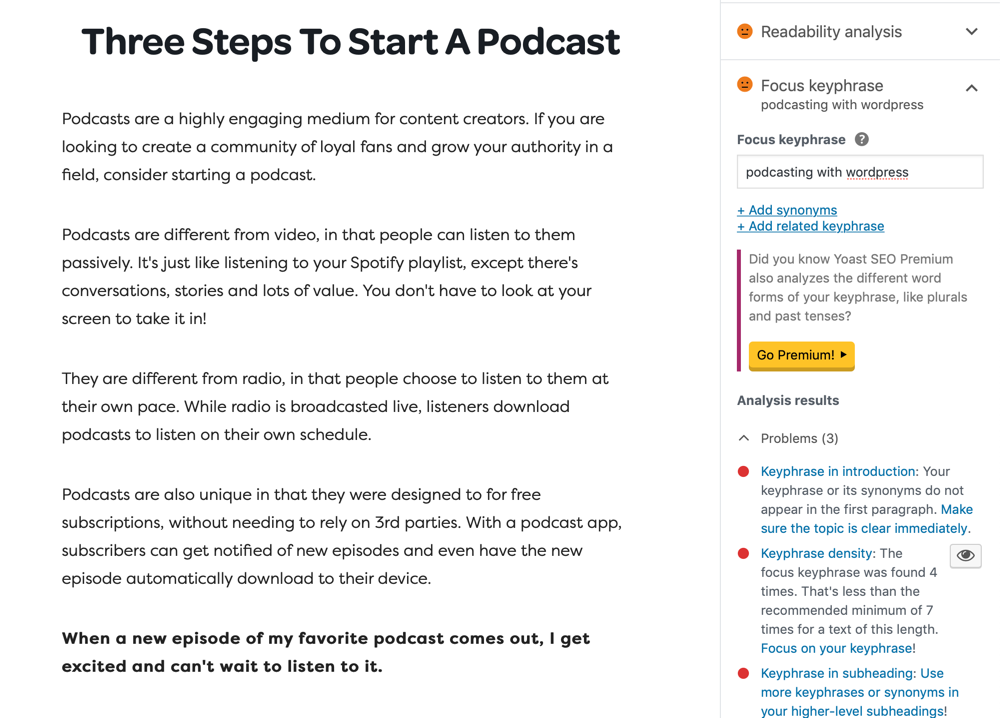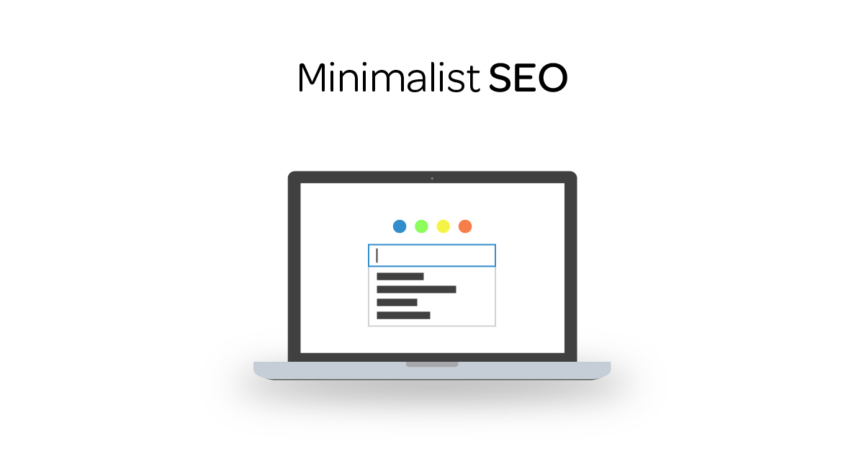Editor’s note: This is an excerpt from the chapter on SEO basics of our Grow Your Audience guide.
SEO is a huge topic, and it’s so confusing! In between the million articles on the internet, advice from Facebook groups, consultants sending you reports of everything wrong on your site, how can you even hope to master the basics of SEO?
First, let me assure you that every new blogger or website owner has been in the same place. The good news is that the basic premise of SEO is quite simple to grasp. Pair that with a little technical knowledge and some consistent effort, and your website will reap the benefits steadily over time.
How this guide is different
Search for “beginner seo guide” and the top results are thousands of words long. This guide is different. Instead of trying to cover everything you need to know, this guide aims for the minimum you need to know. The focus is on actionable steps so you can start applying SEO right now.
Here’s what to expect:
We’ll start by identifying the absolute minimum SEO you need do for each piece of content you produce. If you only have time for one article, this is the one to read.
We’ll then take it a step further by understanding how keywords fit into SEO – how to decide which keywords to target and how to use them in your content.
Next we’ll have a look at improving your website user experience, which is becoming an important ranking factor.
We saved the most technical for last. The chapter will wrap up with how to identify and fix technical issues that can impact your SEO.
Each article in this chapter will take less than 15 minutes to read. If you want to learn more, we’ll direct you to some trusted resources.
A Plain-English Definition Of SEO
Let’s start off our SEO journey by understanding what it is and what it isn’t.
SEO stands for Search Engine Optimization, and is the process of improving search engine rankings in order to increase the quantity and quality of traffic to your website.
When you “do SEO” correctly, you may find…
Visitors to your website or blog are actually reading and engaging with your content. Your keyword research helped you identify what topics your target audience is interested in, so you can create relevant content to attract them.
Your copywriting makes your content readable and ensures visitors understand your message. Side benefit: Google understands it too. Your trustworthy writing style also improves the number of visitors buying from you or signing up to your offers, becoming customers and subscribers.
What’s more, visitors to your site visit more than one page and stay longer. Your efforts in improving the website user experience makes content easy to find, read and navigate. The ease of use causes your website feel trustworthy and more credible too.
From the description above, we can see that SEO is basically all about the website visitor. SEO is all about building a website that your audience will love. And when you do that, the search engines will reward you by sending you lots of traffic.
Build a website your audience will love and Google will reward you for it
But don’t take my word for it. It’s what Google says themselves in their Webmaster Guidelines.
Make pages primarily for users, not for search engines. Avoid tricks intended to improve search engine rankings.
Google Webmaster Guidelines
Google and other search engines are so advanced today that they rank sites based on how we humans like those sites. They now factor the reputation and credibility of a website, and Google is encouraging website owners to improve their user experience by emphasizing page speed and usability.
SEO is not a secret technique that will suddenly send you more traffic. SEO is not about installing the correct plugin. SEO is not about pleasing Google—it’s about pleasing your audience.
So how do we please our website visitors? We start by making a great first impression.
Making A Great First Impression In Search
If you only have time for one nugget of SEO knowledge, you’ve found it. This section explains the two basic SEO techniques that gives you the biggest bang for your buck.
As we explained previously, the goal is to get visitors to love your website. Do that and Google will love you too, rewarding you with more traffic.
To woo your website visitors, start by making a great first impression. Consider these search results. Which would you rather click on?


Obviously the 2nd result right? Unfortunately a good-looking (optimized) search result doesn’t happen automatically. Therefore our first tip is to learn how to make your search results snippet look good—and more importantly—get search users to click to your website.
Page Titles and Descriptions
A single item shown on the search results page is called a snippet. It consists of a SEO title (in blue), the URL (in green), and the meta description (in black).
To ensure you have the best looking snippet possible on the results page, you’ll want to be able to control the text for the SEO title and meta description. We can do this by using one of the many SEO plugins available for WordPress. We are using the Yoast SEO plugin as an example in this guide, but the same principles apply to any other SEO plugin.
SEO Basics Tip #1
Attractive Search Snippets Make Great First Impressions
Optimizing Search Snippets for Posts and Pages
The goal of this step is to make your search snippet attractive so that search engine users want to click on it.
Your SEO plugin will typically add some fields to the post editor for controlling the SEO title and descriptions. Here’s how it looks with the Yoast SEO plugin.

Click the Edit snippet button and you’ll be able to set a title and description for the post or page that you’re editing. A live preview shows you how your snippet will look in the search results and a progress bar indicates the optimal length for your title and description.
Important! Make sure your snippet reflects the content of your page. Your website visitors aren’t going to be happy if their first impressions turned out to be false advertising instead. That is why it is important to make sure your custom title and description reflect what is on the page.
With this in mind, if you set your page title to The best Pepperoni Pizza in Miami, your page should be about pepperoni pizza and your subject should be located in Miami. Google is very good at detecting inaccurate—and even deceptive—SEO, and may penalize your website for it.
Subsequently, the next question is: What should your search snippet say? Figuring out the keywords or keyphrases your audience uses will help you decide. We explain further in the next article: How to use keywords in your content. In the meantime, ensure that the search snippet summarizes the content of your page in an interesting way.
Attractive Results Rank Higher
Optimizing your search results snippet doesn’t just make it look good – it will also help you rank higher. Search engines often use the click through rate to determine a website’s ranking. Brian Dean from Backlinko explains how to take advantage of this in his video below.
Set a SEO Title Template
Do I need to optimize each of my blog posts and pages?
If they are important pieces of content (a.k.a. cornerstone content) to growing your audience, I recommend that you do.
For the other content on that you don’t need or want to optimize manually, you can fall back to a default template for SEO title and description. To do that with the Yoast SEO plugin, navigate to SEO → Search Appearance → Content Types. For each content type, you can create a template by filling in the fields with the available snippet variables.

We recommend the template above. This will give you titles like this:

Tip: You can change the separator from the General tab.
Optimize Your Content
By optimizing our page titles and description, we’ve put our best foot forward in the search results. But what happens after the user clicks through to your website?
We want to ensure that we’re impressing them with our content too. So our goal here is two-fold:
- Create clear, understandable content that meets the searchers’ needs
- Ensure our focus keyphrase is used in high-value locations throughout the content to rank higher for that keyword
But how will we know that we’ve met these goals? That’s where your SEO plugin’s content analysis feature will help.
SEO Basics Tip #2
Quality Content Impresses Website Visitors AND Search Engines
Content Analysis with Yoast SEO
Most SEO plugins now offer content analysis to grade your content for SEO. As with before, we’ll continue using the Yoast SEO plugin in our examples.

Here is a post before optimization. The Yoast SEO sidebar has been activated, and we’ve filled in “podcasting with wordpress” the focus keyphrase. Yoast analyzes the text content of the post and has given it an orange ? rating for both Readability analysis and Focus keyphrase. You can expand each section to see the Analysis results and recommendations.
The plugin not only tells you what the problems are, but how to resolve it and recommendations. If you click on the blue text in the problem description, you’re presented with even more info on how to fix it.
After addressing the problems, the plugin updates its analysis in real time and updated it’s rating to green ? – yay! As a result, we can be confident that this piece of content has a good chance of earning the affections of website visitors.
Here’s that article from the example above – Beginners Guide to Podcasting With WordPress. Can you see how it’s been optimized for the keyphrase?
However, getting a green happy face isn’t enough to create content that visitors (and Google) will love. Your content needs to have substance – facts, details, and explained in an engaging manner. If your content sucks in the first place, optimizing it won’t make it much better. You also don’t have to address every problem identified in the analysis to get a green happy face. Optimize your content enough and move on.
If you want to learn more about how to use this excellent tool from Yoast, read their blog post: How to use Yoast SEO’s content analysis tool.
While the free version of Yoast SEO is awesome, if you’re serious about SEO do consider purchasing the premium upgrade.
Do you find it hard to create high-quality content? If you do, follow the steps in Fizzle’s free 80/20 Copywriting Workbook. We can’t recommend it highly enough.
Other WordPress SEO Plugins
While we are big fans of Yoast SEO, it is by no means the only SEO plugin available for WordPress. Here are some alternatives for you to consider.
- SEOPress is an all-in-one plugin that also includes Google Analytics integration.
- The SEO Framework bills itself as a smart plugin that uses AI to enable optimal settings for your site.
- Rank Math is a lightweight and modular plugin that claims to help SEO tasks.
- All in One SEO Pack is the original Yoast SEO alternative with many fans of its slim and utilitarian interface.
As you can see, there are many options for you to choose from. Pick one, learn its features and stick with it. Above all, remember that…
SEO Is More Than A Plugin
It’s tempting to leave all the SEO tasks to a plugin. But as I have shown, the essential SEO tasks aren’t all that difficult:
- Optimize your search titles and descriptions
- Produce readable content with your focus keyphrase
These are tasks that can’t be automatically done by a plugin, regardless how smart it is. You must still take the time to do these steps yourself. With some consistent effort, visitors will fall in love with your website and Google will reward you with a flood of SEO traffic.
This is an excerpt from the chapter on SEO basics of our Grow Your Audience guide. Continue reading the next article: How To Use Keywords In Your Content




As a digital marketer, I can’t stress enough the importance of implementing the absolute minimum SEO practices on every website. Even if you’re not an expert, these basic steps can significantly improve your site’s visibility and accessibility to search engines, ultimately driving more organic traffic. Things like optimizing meta titles and descriptions, using relevant keywords in your content, ensuring your site has a clear site structure and navigation, and creating an XML sitemap are fundamental yet crucial elements. While SEO can seem overwhelming, starting with these essentials lays a strong foundation for future optimization efforts. Remember, SEO is not a one-time task but an ongoing process, so it’s essential to continuously monitor and refine your strategies to stay competitive in the ever-evolving digital landscape.